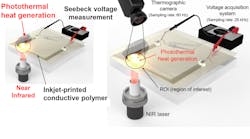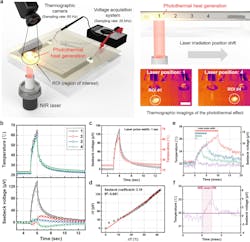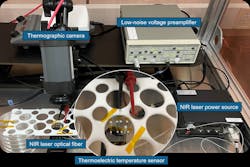What you’ll learn:
- Why fast-response, non-contact temperature sensing is needed in biomedical research.
- How thin, transparent film is used to create the Seebeck effect to measure temperature.
- The instrumentation arrangement employed to test the performance.
Temperature is among the most widely measured real-world physical parameters—no news there. Sometimes it’s almost trivial to measure it, other times it’s done with some difficulty, and in yet other cases, it’s very difficult to measure due to accessibility or required range of readings. Another challenge is when you need to create and then measure highly localized changes, when the mass of the sensor adds the thermal mass of the region of interest (ROI) and slows down response, or even affects the temperature achievable with the ROI.
It may seem that such heating localization and sensing-response speed aren’t needed in the relatively slow-moving world of biomedical applications. However, the photothermal effect is particularly useful for various biomedical-research applications such as neuromodulation, photothermal therapy, photothermal polymerase chain reaction (PCR), retina function restoration, and photothermal drug delivery.
For example, laser pulses just a few milliseconds in length can induce excitatory stimulation of neuronal cells by depolarizing the transmembrane potential, while pulses of 20 ms or longer have been reported to cause inhibitory stimulation of neuronal cells. Therefore, to understand the underlying mechanism, it’s important to monitor precise temperature changes at high temporal resolution and within close proximity.
Leveraging the Seebeck Effect
To address these issues, a team led by researchers at DGIST (Daegu Gyeongbuk Institute of Science and Technology, Republic of Korea) and other Korean institutions combined the well-known Seebeck effect—which we normally associate with dissimilar metallic contact pairings—with a transparent temperature sensor capable of precisely and quickly measuring temp changes caused by light.
It measures rapid temperature changes in less than a few milliseconds by using the thermoelectric effect, in which a voltage signal is generated by rapid charge transfer triggered by a difference in temperature.
How’d They Do It?
The team used a direct photothermal-measurement technology with reduced interference by light. They chose an organic thermoelectric layer of transparent PEDOT:PSS, a conductive polymer suitable for storing charges (Fig. 1). (In case you’re wondering, its formal name is poly(3,4-ethylenedioxythiophene) polystyrene sulfonate, a polymer mixture of two ionomers.)
The 50-nm-thin PEDOT:PSS thermoelectric (TE) sensor offers high transparency at 97% (on average) in the visible-light zone. It can be directly applied to the area of photothermal phenomenon, minimizing light interference in photothermal bioengineering and medical applications. In addition, since a low-temperature solution process could be used for the polymer thermoelectric material, it was prepared with an inkjet printing process, which is simpler to manufacture than a general semiconductor process.
The biocompatible polymer-thermoelectric materials are optimized to achieve transparency. As a result, they become insensitive to laser irradiation for direct photothermal effect sensing in the sub-millisecond range. At the same time, they maintain high thermoelectric-temperature sensitivity.
In photothermal heating, absorbed optical energy from a light source is converted to thermal energy. Thus, the thermal effect can be highly localized down to sub-micron spatial resolution (Fig. 2).
Evaluation
It's often interesting to see the arrangement of instrumentation researchers set up for their tests and evaluation. For this project, near-infrared (NIR) light is conveyed to the ROI by an optical fiber while a low-noise voltage preamplifier captures the Seebeck voltage across the TE layer of interest. A thermographic IR camera measures the maximum temperature (Fig. 3).
The work is described in detail in their paper “High temporal resolution transparent thermoelectric temperature sensors for photothermal effect sensing” published in Materials Horizons (The Royal Society of Chemistry) along with a Supplementary Information file.



